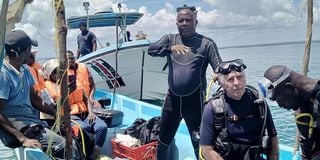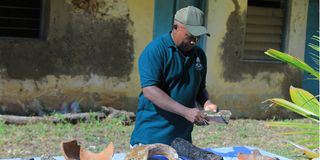
National Museum of Kenya Coast Regional Head of Archaeology Department Dr Ceaser Bita (standing, in diving gears) and Prof Fillipe Castro (seated) prepare to dive in the Indian Ocean during the ongoing research on the wreckage of ship believed to have been owned by ancient sailor Vasco Da Gama.
The discovery of one of Vasco da Gama’s ship off the coast of Malindi is one of the most fascinating stories in recent past. However, what was contained in the shipwreck has not been made public yet, and that is why there is excitement after the Journal of Maritime Archeology published an article two weeks ago about the artifacts that have been lying under the waves for 500 years making the discovery an unparalleled treasure trove of historical and cultural significance.
If the Ministry of Heritage (President Ruto has yet to appoint a substantive Cabinet Secretary) and the Ministry of Tourism are genuinely committed to leveraging the nexus between heritage and tourism, the Ngomeni Shipwreck, as it is known, offers an unparalleled opportunity to merge historical preservation with economic growth. The artifacts retrieved from the wreck, believed to be that of Sao Jorge, are not merely remnants of the past; they represent a tangible connection to the rich maritime history that positioned the East African coast as a vital hub in global trade networks during the Age of Exploration.
The 1524 voyage of the Sao Jorge, captained by one of da Gama’s trusted lieutenants, marked a period of transition for Portuguese naval dominance in the Indian Ocean. Its sinking, likely caused by treacherous waters or structural failure, the ship became an unwitting time capsule, preserving remnants of its journey for nearly five centuries. Initial surveys of the site have uncovered fragments of the ship’s hull, ceramics, and navigational instruments, each telling a fragment of the larger story.
If proven to be the Sao Jorge, the Ngomeni Shipwreck would stand as one of the earliest European vessels recovered in the Indian Ocean, which makes Malindi a centre in the study of business cultures some 500 years ago. Beyond its academic significance, the wreck offers an evocative reminder of the perils and ambitions that defined early seafaring expeditions.
Many people have not heard of the Ngomeni shipwreck, though it was discovered in 2007 by local fishermen.
Certainly, this is because there is little civic education on the importance of such findings – even within the media. But now, archeologists have settled that this was possibly Sao Jorge, one of Vasco da Gama’s ship that vanished with its cargo in 1524 – or perhaps Nossa Senhora da Grace, which disappeared in the same area in 1544. That means that we are dealing with artifacts that have been under water for the last 500 years. And that is why this is exciting news to scholars of maritime history, and archeologists alike.
Ngomeni wreck
And what have they discovered inside Ngomeni wreck? The journal reports that a “significant portion of the hull” is preserved – though it is buried under the sediment. There are also some copper ingots, ivory tusks set to be analysed for DNA, stone anchors, milling stones, a wooden bucket, animal bones, ceramics from Persia and China and porcelain sherds.
If confirmed, this extraordinary find could rewrite the narrative of Kenya’s coastal heritage and give Malindi an extra kick as a global hub for historical tourism. But that depends on how we take advantage of this discovery – and how we later display the finds. The shipwreck, according to the archeologists who have studied the site, presents an “opportunity to study and publish a shipwreck from this period.”
For centuries, Vasco da Gama’s name has resonated in Kenya, since he is one of the explorers introduced to students in primary school. As such, some Kenyans looks at Vasco da Gama’s story as one of the most thrilling in the study of history of ancient commerce.
Though it is known that he had left Lisbon in an armada of 19 ships and 3,000 men in 1524, and that one of his ships sank near Malindi, the discovery of this ship, adds another exciting layer in the history of Malindi and its contact with foreign traders.
Over the years, Kenyans and international visitors have always marveled at the iconic Vasco da Gama Pillar in Malindi or the grandiose Fort Jesus in Mombasa — both lasting testaments to the Portuguese influence along the East African coast. The Ngomeni discovery offers something far more tangible: a direct link to the vessels that shaped maritime history and ushered in new eras of global trade and cultural exchange.
So where do we go from here? To maximise the potential of this discovery, the ministries should consider a multi-faceted approach. First, they could establish a dedicated maritime heritage museum in Malindi, showcasing the artifacts alongside interactive exhibits detailing the historical context of Vasco da Gama’s voyages. Such a museum would serve as an educational resource for local and international visitors, fostering a deeper appreciation for Kenya’s coastal heritage. Those who have seen the Titanic museums know how much such an outfit can generate.
Kenya’s heritage
Additionally, the Ngomeni Shipwreck could be transformed into an anchor point for underwater tourism. With proper preservation and regulation, diving excursions to the site could attract enthusiasts and archaeologists from around the globe, generating revenue while promoting sustainable tourism practices. Collaborations with international maritime archaeology institutions could further enhance the site’s credibility and draw global attention.
Moreover, the ministries could launch a robust marketing campaign, positioning the Ngomeni Shipwreck as another cornerstone of Kenya’s heritage tourism.

National Museum of Kenya Coast Regional Head of Archaeology Department Dr Ceaser Bita displays some of the items recovered from the wreckage of a ship believed to have been owned by ancient sailor Vasco Da Gama.
In many countries, such shipwrecks are important because they silence some narratives and they give us a rare glimpse into the shipbuilding craftsmanship, trade routes, and navigational prowess of 16th-century explorers. Since few Portuguese ships from this period have been found and excavated, the Ngomeni shipwreck is quite important. As archaeologists continue to meticulously piece together the story of this ill-fated voyage, they are uncovering insights into the tools and techniques that defined one of history’s most important maritime epochs.
One of the archeologists involved in the study said: “This could be a game-changer for the Kenyan coast. The Ngomeni Shipwreck is not just a relic of the past; it’s a gateway to understanding the global connections that shaped our modern world.”
The Ngomeni Shipwreck is not just a relic of historical significance; it represents a cultural treasure that has the potential to elevate Malindi’s profile on the global tourism map. This discovery could do for Malindi what the Titanic has done for Halifax, Canada—a city that has skillfully integrated the ship’s legacy into its cultural identity, drawing scholars, tourists, and maritime enthusiasts from across the globe. Similarly, Malindi stands at the cusp of transforming the Ngomeni Shipwreck into a symbol of Kenya’s rich maritime heritage, underscoring its historical role as a bustling hub of commerce and exploration.
This shipwreck offers unprecedented opportunities for a diverse audience. For historians and archaeologists, it is a gateway to unraveling the mysteries of the Age of Exploration. For tourists, it presents an alluring adventure steeped in history and discovery. The shipwreck has the potential to serve as the linchpin for sustainable cultural tourism in the region—one that celebrates our shared heritage while creating economic opportunities for local communities.
However, the realisation of this vision requires proactive engagement. Malindi’s community and heritage stakeholders, including museums and the Kilifi County government, must recognise and invest in the shipwreck’s potential. This calls for collaborative strategies to document, preserve, and promote the site as a heritage landmark.
The challenge lies in shifting focus from the easy allure of beach tourism to a more profound investment in our cultural and historical assets. While beaches remain a key attraction, heritage tourism offers a richer, more sustainable avenue for economic and cultural development. The question we must ask ourselves is this: Are we willing to embrace the challenge of building a heritage-based tourism framework that not only diversifies our offerings but also preserves our history for future generations?
The choice is ours. Do we seize this opportunity, or do we let it slip away into the sands of time?
@johnkamau1 @[email protected]









